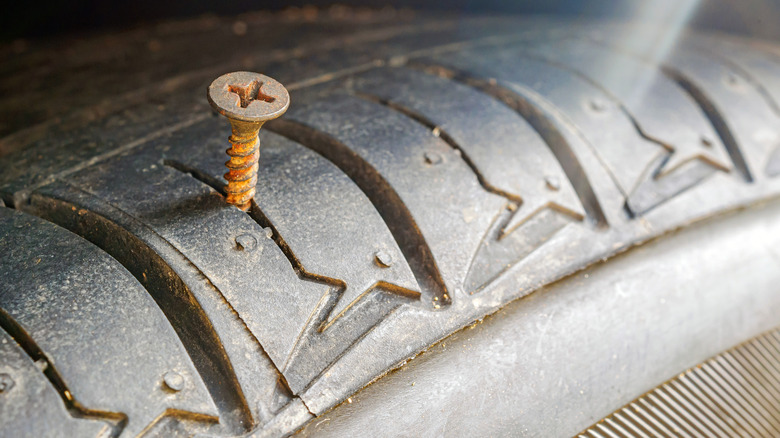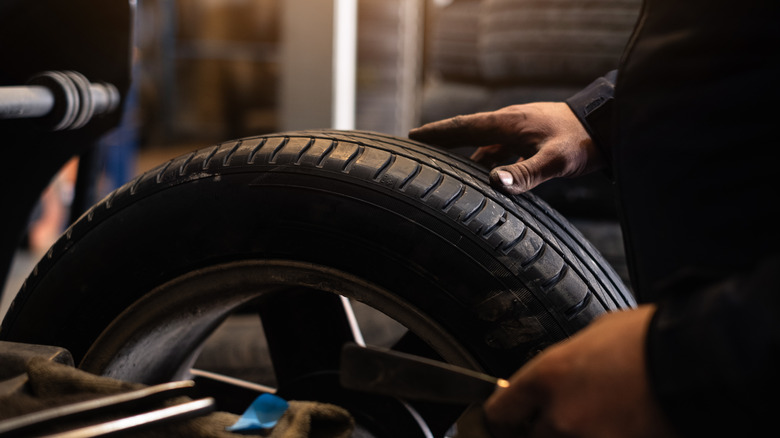Tire speed ratings basically tell you how fast you can go before your tires turn into shrapnel. Your everyday grocery-getters can get away with, say, inexpensive S-rated tires that will hold together up to 112 mph, a speed manufacturers determine by spinning said tire in a machine that simulates road speeds and pressures until it disintegrates. But an S-rated tire won’t do for a vehicle such as the monstrous 670-hp C8 Corvette Z06, which requires pricier (Y)/ZR tires, big enough to use as coozies on an oil drum, to reach its 195 mph potential.
Oh, and heaven help you if you have a high-speed-rated tire that needs a repair. You bought your V, W, Y, or Z-rated tire specifically to exceed the 130 mph limit of H-rated tires, and they’re not cheap, but depending on the manufacturer, a repair means you might have to kiss your speed rating goodbye. Once that happens, your tires might as well be made out of cheese, because you’re not going to blast around a track until you get new ones.
Tire manufacturers have strict rules about the number and type of repairs a high-speed tire can receive before it basically isn’t a high-speed tire anymore. Sometimes that number is “none.” Since manufacturers don’t have crystal balls to see how long their fast-car tires were driven with low pressure, the severity of the tires’ wounds, or whether the repair is a quality one, it’s safer for most of them to just say, “Don’t drive fast on it anymore.” The way Bridgestone puts it, “Speed ratings do not apply to tires that have been damaged, altered, under-inflated, overloaded or repaired.”
Manufacturer policies for repairing your speed-rated tires
Remember, some areas on a tire can be patched and some can’t, which isn’t the fault of the manufacturers — it’s just the way tires are. Each brand has its own rules about whether a high-speed rated tire can still be used for its intended purpose after a repair. Michelin, for example, says, “If the speed rating on the sidewall of your tyre [love the British spelling] does not exceed the T rating [max 118 mph], the sidewall is repairable if the hole is 3mm or less in diameter [four-fifths of an inch]. Beyond this index, tyre repair is strongly disadvised to avoid any safety risk.”
Goodyear/Dunlop/Kelly-Springfield tires are a little more forgiving, but have no patience for mediocre repair work. Goodyear Tire & Rubber’s policy states, “A Goodyear, Dunlop or Kelly-Springfield manufactured speed-rated tire may be repaired to correct a commonly repairable nail hole puncture in the tread area only, but proper materials and procedures must be applied. INCORRECT OR IMPROPER REPAIR WILL RESULT IN THE TIRE NO LONGER BEING SPEED-RATED BY GOODYEAR.” That’s Goodyear’s all-caps typing, not mine.
Then there are the zero-tolerance manufacturers such as Bridgestone, Cooper, Falken, Firestone, and Sumitomo, who will look at your patched-up speed-rated tire and just shake their heads. Yup, a single repair eliminates your speed rating, limiting you to 85 mph or less.
Speed ratings are kind of confusing
Should you have unrepairable speed-rated tires, it’s time to upgrade your performance tires this summer anyway. Let’s see which speed rating you might want. Once upon a time, 149+ mph Z-rated tires were as high as speed ratings went, like how professional heavyweight boxers go from 200 pounds to infinity. As top speeds increased, tires needed more specific speed ratings, resulting in W- and Y-rated tires that can reach 168 and 186 mph, respectively.
The Z couldn’t die, though. W- and Y-rated tires sometimes also get “ZR” printed on the side, indicating they can go above 149 mph. If a tire is designed for speeds greater than 186 mph, the “ZR” becomes a requirement, as does a (Y) in parentheses. Confused yet? Let’s make it worse. Just as there are like 39 different varieties of Vitamin B, A-rated tires were named A1 through A8 before someone thought to move on to the next letter. Don’t look for I, O, or X tires, they don’t exist. Probably best we don’t have an X-rated tire, honestly; that would be a tough purchase to explain to non-car people.
The 130 mph H-rating sits between 124 mph U- and 149 mph V-rated tires. Wait, 149 mph, like Z-rated tires? No, V and Z ratings aren’t the same, V is for tires up to 149 mph, and Z is for tires over 149 mph, unless those tires are W or Y-rated, in which case they may also be rated ZR, except when they aren’t, or after a repair or two or three or none, depending on manufacturer policy. Got all that?
Source link





